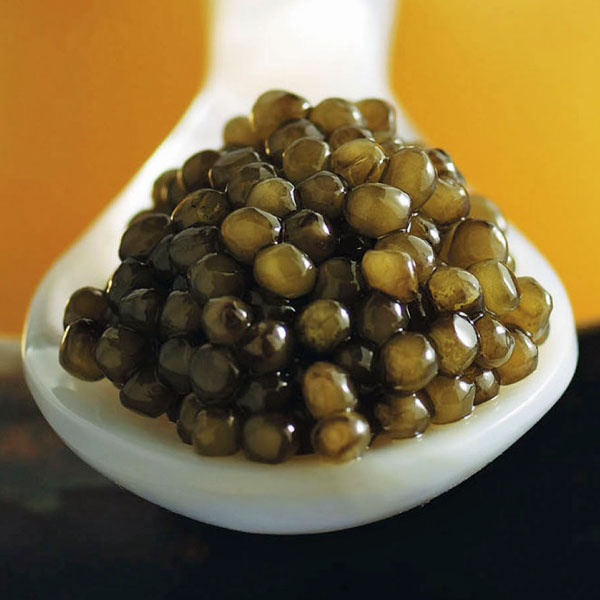Crazy for Caviar
Category : Food Stories, Party Ideas, Recipes, Press Room |
Posted : Dec 30, 2004
Thursday, December 30, 2004
Crazy for Caviar
BY PAMELA ROBIN BRANDT,
http://www.miaminewtimes.com/issues/2004-12-30/dining/cafe2.html
 It's traditional to eat certain foods at the stroke of midnight on New Year's Eve to ensure good luck in the coming year. This lucky food varies from country to country. Cubans eat twelve grapes. In Germany, Poland, and Scandinavia the first bite is supposed to be herring. For those of us who need all the luck we can get, this is a dilemma. Take it from one who's tried it: Pickled herring and grapes together do not taste like an auspicious start to the year, even when accompanied by the traditional New Year's beverage, champagne.
It's traditional to eat certain foods at the stroke of midnight on New Year's Eve to ensure good luck in the coming year. This lucky food varies from country to country. Cubans eat twelve grapes. In Germany, Poland, and Scandinavia the first bite is supposed to be herring. For those of us who need all the luck we can get, this is a dilemma. Take it from one who's tried it: Pickled herring and grapes together do not taste like an auspicious start to the year, even when accompanied by the traditional New Year's beverage, champagne.
That's why many prefer to start the year with the food that goes best with champagne: caviar. Americans consume roughly one-third of the world's caviar, which, like oil, has been called "black gold." And at today's prices for genuine beluga, osetra, and sevruga caviar from the Caspian Sea (home to 70 percent of the world's sturgeon population), the term is especially apt. Even at Marky's, a Russian gourmet market that has Miami's best prices for fresh caviar, Caspian sturgeon roe runs from $38 to $170 for a single ounce -- barely enough to serve one, much less a New Year's gathering of family and friends.
For those who love the real thing, the inexpensive unrefrigerated faux "caviars" sold in supermarkets are no substitute. Generally very salty, oily, fishy, and charmless in texture (either all hard crunch, like grains of slimy sand, or squished), they're nothing but pretentious pretense. Luckily, Marky's offers an alternative: three affordable all-American roes that are ringers for Caspian caviar, but which in blind taste tests have fooled even some experts. The roes, which are fresh (unpasteurized) and only minimally salted, come from three greater Mississippi Valley fish: hackleback, a type of white sturgeon; paddlefish, a prehistoric snout-nosed fish related to sharks; and bowfin, a.k.a. dogfish or blackfish. The price: $8.80 to $11 per ounce.
Though beluga eggs are the largest and most luxe (three or four times the price of the other two Caspian caviars), many aficionados prefer the relative firmness and unique nuttiness of osetra. Marky's hackleback caviar comes remarkably close. Some of the slightly sweet fruit or herb tones that make osetra's flavor so complex were lacking, but the nutty richness was there. So was osetra's extremely subtle tang (more like champagne than brine), silken texture, and clean aftertaste.
Paddlefish roe is known as "American sevruga," and the dark-gray eggs are indeed virtually indistinguishable in size and color from their Caspian cousins. In taste and texture, however, the paddlefish caviar is in many ways more like beluga. While the individual eggs are admirably distinct (each one unbroken rather than a mushy matrix), they lack sevruga roe's pronounced (and fun) pop. Instead, like beluga, they are elegantly delicate. The flavor is mild, not as bracing as sevruga but with enough clean liveliness to imbue charm.
In both taste and texture, the smaller-beaded bowfin caviar at Marky's is less refined than the other two, but its more intense briny tang provides interesting and very welcome contrast. To balance and tame its relatively strong flavor, the jet-black roe is best served in tiny Siljans-brand croustade pastry shells, warmed with a little butter to maximize their rich crispness and filled with imported French creme frache (also available at Marky's for $3, about half the price of most local gourmet stores). Sprinkle the shells with lemon and diced sweet onion right before popping it in your mouth.
This creme frache/caviar cup treatment would have worked well with the paddlefish and hackleback caviars too, in terms of taste and also to stretch the stuff for a New Year's gathering. If you're alone, however, both these roes are elegant enough to eat with the only accompaniment I feel is necessary for Caspian caviar: a spoon.














